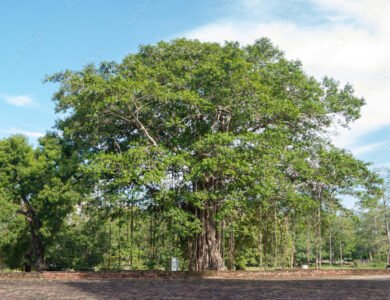
Ficus religiosa, also known as the Sacred Fig, Peepal Tree, or Bo Tree, is a species of fig tree native to the Indian subcontinent and Southeast Asia. This remarkable tree holds a special place in many cultures and religions, most notably in Buddhism, where it is believed to be the tree under which Buddha attained enlightenment. With its wide-reaching branches, heart-shaped leaves, and religious importance, Ficus religiosa is not only revered for its spiritual significance but also admired for its striking appearance and ecological benefits.
Key Features of Ficus Religiosa
Ficus religiosa is known for several unique features that distinguish it from other members of the Ficus genus:
- Heart-shaped Leaves
The leaves of the Sacred Fig are large, glossy, and distinctly heart-shaped with pointed tips. These leaves have a long, slender petiole, making them highly recognizable. As the tree matures, the leaves become darker and larger, adding to the tree’s impressive stature. - Aerial Roots
Like many other Ficus species, Ficus religiosa develops aerial roots that grow down from the branches and into the soil. These roots help support the tree and allow it to thrive in diverse environments. The roots also contribute to the tree’s striking appearance, especially when they drape down and create a lush canopy. - Tree Size and Growth
The Ficus religiosa can grow up to 100 feet tall in its natural habitat, with a canopy that spreads wide. It thrives in tropical and subtropical climates, making it ideal for regions with warm temperatures. Its rapid growth and expansive roots make it a popular choice for both sacred and ornamental purposes.
Cultural and Religious Significance
Ficus religiosa holds immense cultural and religious significance, especially in Hinduism, Buddhism, and Jainism:
- Buddhism
According to Buddhist tradition, the Buddha attained enlightenment under a Ficus religiosa tree, also known as the Bodhi Tree, in Bodh Gaya, India. This makes the tree one of the most sacred symbols in Buddhism, representing wisdom, enlightenment, and peace. - Hinduism
In Hinduism, the Ficus religiosa is associated with the god Vishnu and is considered a symbol of prosperity, fertility, and longevity. Many Hindus plant these trees near temples and homes, believing that they provide spiritual benefits and blessings. - Jainism
In Jainism, Ficus religiosa is also considered sacred, with religious texts often referring to its importance in spiritual practices. It is believed that the tree represents the interconnection of all life forms and embodies a sense of harmony in the natural world.
Growing Ficus Religiosa
Ficus religiosa is a hardy and adaptable tree, but growing it successfully requires attention to specific environmental needs:
- Light Requirements
This tree thrives in full sunlight and should be planted in a location where it will receive several hours of direct sunlight each day. It can tolerate some shade, but it grows best when exposed to abundant light. - Watering Needs
Ficus religiosa prefers consistently moist soil, particularly during its growing season. However, it does not tolerate waterlogged soil. Make sure the tree is planted in well-draining soil to avoid root rot. Water regularly during dry periods, but allow the soil to dry out between waterings. - Soil Conditions
The Sacred Fig grows well in a variety of soils, but it prefers loamy and slightly acidic soil that drains well. A mixture of organic matter can help provide the necessary nutrients for healthy growth. - Temperature and Humidity
Ficus religiosa is a tropical tree that thrives in warm temperatures ranging from 65-85°F (18-29°C). It is best suited for tropical or subtropical climates but can also be grown indoors in temperate regions if given enough light and warmth. The tree enjoys high humidity, so it’s essential to ensure that it is not exposed to dry conditions for long periods.
Benefits and Uses of Ficus Religiosa
Ficus religiosa is not only revered for its spiritual significance but also provides several practical benefits:
- Shade and Shelter
Due to its large size and dense canopy, the Ficus religiosa makes an excellent shade tree. In hot climates, it can provide much-needed relief from the sun, creating a cool, comfortable environment beneath its broad leaves. - Ecosystem Benefits
This tree plays an essential role in the ecosystem by offering habitat and food for various wildlife species, including birds, insects, and small mammals. The fruits of the Sacred Fig are small and fig-like, attracting animals that feed on them. - Medicinal Uses
In traditional medicine, parts of the Ficus religiosa tree, including its bark and leaves, have been used for various therapeutic purposes. It is believed to have anti-inflammatory, antidiabetic, and antimicrobial properties, though scientific studies on its medicinal uses are still ongoing.
Conclusion
Ficus religiosa, or the Sacred Fig, is much more than just a tree. With its unique, heart-shaped leaves, significant cultural and religious importance, and ecological benefits, it is a plant that commands respect and admiration across the world. Whether you are growing it for its beauty, spiritual meaning, or environmental contributions, this resilient tree is a valuable addition to any garden or landscape. For those interested in the connection between nature and spirituality, Ficus religiosa offers a powerful symbol of enlightenment, prosperity, and harmony.


One Comment